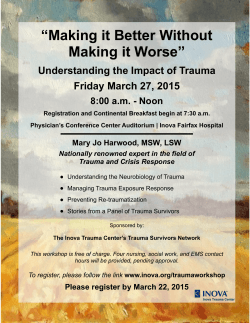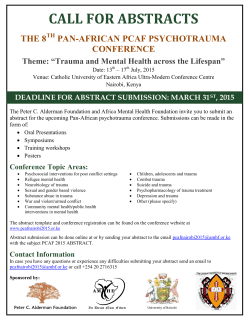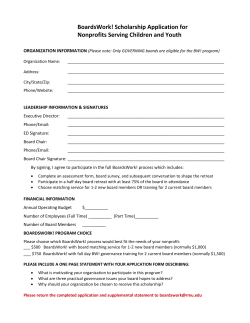
Transcript - LWW Journals
Issue Highlights Journal of Trauma and Acute Care Surgery Volume 78, Issue 4 April 2015 Jo Fields: Welcome to Trauma Loupes, the Journal of Trauma and Acute Care Surgery’s monthly podcast. This is Jo Fields. For this April 2015 issue, we hear from our editor in chief, Dr. Ernest Moore, and our biostatistician, Dr. Angela Sauaia, with their must reads. First, Dr. Moore: Dr. Gene Moore: Welcome to the April issue of the Journal. The lead articles are the AAST Presidential Address entitled “Responsibility” by Dr. Bill Cioffi and the Fitts Lecture “Genomics of Injury: The Glue Grant Experience” by Dr. Ron Tompkins. Both are must-reads as they contain invaluable material that all acute care surgeons should know, but too much to effectively summarize in a podcast. The first paper to discuss is by Dr. Marty Schreiber and colleagues of the Resuscitation Outcome Consortium who completed a randomized trial comparing prehospital limited crystalloid versus standard crystalloid resuscitation. The limited cohort received 250 ml boluses of normal saline to maintain a SBP > versus a target of 110 mm of mercury until in the control group. Interestingly, the difference in crystalloid administered was relatively small, one versus two liters. In the blunt injured cohort, the 24 hours mortality was 3% in the limited versus 18% in the standard with an adjusted odds ratio of 0.17; a 95% confidence interval of 0.03 to 0.92. For penetrating wounds, there was no difference in mortality. Unfortunately, this trial was terminated at 192 patients because of a new ROC study. One of the other limitations was that the median ISS was only nine in these study patients. Nonetheless, as the authors conclude, this trial indicates that limited resuscitation is feasible and warrants a large-scale phase III trial. The next paper that is particularly timely is by Dr. Tatsuyo Norii and colleagues who examine the impact of resuscitation endovascular balloon occlusion of the aorta on survival following blunt trauma using the Japanese Trauma Data Bank from 2004-2011. Of more than 45,000 patients in the registry, 1% underwent REBOA. Propensity scoring was employed, matching REBOA to non-REBOA patients in a ratio of 1 : 5. The provocative finding was that the odds ratio of survival in the REBOA group was 0.30 with a 95% confidence interval of 0.23 to 0.40. Now it is important to emphasize that in Japan postinjury REBOA is typically placed by emergency physicians, with trauma surgeons on call from out of the hospital. © 2015 American Association for the Surgery of Trauma The Journal of Trauma and Acute Care Surgery Issue Highlights Volume 78, Issue 4 April 2015 While the response to trauma is clearly different in Japan, this study has implications as we continue to integrate REBOA into the resuscitation of critically injured patients in the United States Another timely report is by Dr. Peter Rhee and colleagues from the University of Arizona and the University of Southern California who review their experience with transfusion of auto transfused whole blood from hemothoraces, collected with chest tubes and anticoagulated with CPD. Patients with whole blood auto transfusion numbered 136 were compared to those who did not, employing a propensity score matching at a 1 : 1 ratio. Patients with auto transfusion required less units of red cells (7 versus 9) and platelets (5 versus 7), although there were no differences in other outcome measures. This is a particularly interesting report in light of the ongoing discussion of the potential benefits of fresh whole blood transfusion to mitigate trauma-induced coagulopathy. But it is important to recognize that blood collected from a hemothorax is quantitatively different from whole blood obtained from a venous catheter, and there has been concern of adverse effects on the coagulation system when large volumes of intracavitary-collected blood are transfused. The final paper to highlight is authored by Dr. Ben Howard and colleagues from the San Francisco General who fundamentally demonstrate that patients with isolated hypoxemia (Pa02/Fi02 < 300) are different from those who are hypoxemia and meet Berlin criteria for ARDS, that is, bilateral pulmonary opacities on chest x-ray. Of 621 injured patients requiring mechanical ventilation, 65% developed hypoxemia and 30% ARDS with hypoxemia. Examining the three groups (no hypoxemia, isolated hypoxemia, and ARDS), there was a progressive increase in severity of shock, severity of overall injury, and severity of chest trauma as well as incidences of pneumonia, multiple organ failure, ventilator days, ICU stay, and mortality – as expected. However, in multiple logistics regression, independent predictors of hypoxemia were early plasma from (zero to six hours), delayed crystalloid from (7 to 24 hours), and head and chest injury; whereas, predicators of ARDS were early crystalloid (zero to six hours), delayed platelets (7 to 24 hours) and head and chest injury. In sum, the authors conclude that hypoxemia and ARDS represent distinct clinical states, with unique predictors that should be recognized in designing therapeutic strategies. As usual, there is abundant other important information in this issue. Happy reading! Jo Fields: Thank you Dr. Moore. And now, Dr. Sauaia: © 2015 American Association for the Surgery of Trauma The Journal of Trauma and Acute Care Surgery Issue Highlights Volume 78, Issue 4 April 2015 Dr. Angela Sauaia: Hello, everyone. Today I would like to acknowledge two important topics represented in this April issue of our Journal. The first is the increasing number of articles addressing the elderly population. As I age myself, a nice alternative to pushing daises, I too became more interested in this fast growing segment of our population. The research design and analysis of studies addressing older populations present interesting challenges. In fact, a recent article in JAGS, the Journal of the American Geriatric Association, goes as far as proposing a new sub-discipline named “gerontologic biostatistics”. This may be going too far, but I certainly advocate for a special attention to important characteristics of the elderly as it pertains to research design and statistical analysis. For example, among the elderly, we have a larger representation of patients who are receiving anti-coagulants and get injured by a fall from standing. In this group, two risk factors, i.e., the mechanism of injury and the comorbidity interact and modify each other. Another challenge is the multiple risk factors, which represent a challenge in research design, as they require a large sample size to allow stratified analysis for risk adjustment. Interventions designed for the older populations often need to be multicomponent to address the multiple risk factors. In traditional trials, all participants are eligible for all intervention components, by contrast, in intervention trials addressing geriatric participants, the number and type of risk factors and contraindications vary. Thus, some older patients may be eligible for one component of the intervention but not for the other components. A practice that is becoming more popular is called “standardly-tailored”, in which patients randomized to the intervention arm receive only the intervention components that is appropriate at the time of enrollment and not the other components. Another interesting topic in geriatric trauma research is the need to use multiple outcomes, including cognitive and physical outcomes as well as quality of life, frailty, activities of daily living, and others. The use of multiple outcomes can present statistical challenges, similar to the challenges of multiple comparisons. The second topic I want to address today is propensity score matching. I have talked about this issue before, but we can talk again, as we have two popular studies using this technique in our April issue. Propensity score matching has been proposed as a good approximation of a randomized clinical trial. It entails forming matched sets of treated and untreated subjects who share a similar value of the propensity score. The propensity score is the probability of receiving the treatment in question based on observed baseline covariates © 2015 American Association for the Surgery of Trauma The Journal of Trauma and Acute Care Surgery Issue Highlights Volume 78, Issue 4 April 2015 . For example, in the study by Dr. Norii and colleagues from Japan on REBOA, patients who were submitted to REBOA were matched to patients who had similar propensity score but who, for some reason, were not submitted to REBOA. Their propensity score was obtained by a regression model that included vital signs, age, sex, anatomic injuries and physiology derangement. Traditionally one would match based on these baseline characteristics. For example, a 29-year-old male with pelvic fracture, asystolic who underwent REBOA placement would be paired with a 29 year old male with a pelvic fracture also asystolic who was not treated with REBOA. It is pretty intuitive that finding these pairs is not going to be easy, therefore, we can use a propensity score. The propensity score comes from a regression equation that enters all the variables and produces a probability, much like the TRISS methodology that we now name propensity score. This score can then be used to pair similar, but not identical patients. There are several techniques for propensity score matching. First, one must choose between matching with replacement and matching without replacement. When using matching without replacement, once an untreated subject has been selected to be matched to a given treated subject, that untreated subject is no longer available for matching. As a result, each untreated subject is included in at most one matched set. In contrast, matching with replacement allows a given untreated subject to be included in more than one matched set. When matching with replacement is used, the statistical analysis must account for the fact that the same untreated subject may be in multiple pairs. A second choice is between greedy and optimal matching. In optimal matching, matches are formed to minimize the within-pair difference of the propensity score. While in greedy matching, the nearest untreated subject is selected for matching to the given treated subject. Now, what do I mean by nearest matching score? There are two primary methods for this: nearest neighbor matching and nearest neighbor matching within a specified caliper distance. Nearest neighbor matching selects the untreated subject whose propensity score is closest to that of the treated subject. If multiple untreated subjects have propensity scores that are equally close, one of them is chosen at random. Nearest neighbor matching within a specified caliper distance is similar with the further restriction that the absolute difference of the propensity scores need to be within some pre-specified distance, namely the caliper distance. Therefore, for a given treated subject, one would identify all the untreated subjects whose propensity score lay within that specified distance of the treated subject, and from this set of untreated subjects, the untreated subject whose propensity score was closest to that of the treated subject would be selected for matching. Ugh….so many things to think about © 2015 American Association for the Surgery of Trauma The Journal of Trauma and Acute Care Surgery Issue Highlights Volume 78, Issue 4 April 2015 ! But now, the most important question? Is propensity score matching really a substitute for randomized trials? The answer is, as usual, it depends. For situations where a RCT is impossible or inappropriate, the propensity score matching offers a good alternative. Classic cases where RCTs are not possible are heavy drug use or gun possession, where one cannot randomize people to be a heavy drug user or to become a gun owner. However, we must keep in mind that a propensity score is limited to observed variables that are included in the model used to derive the score. A randomized trial accounts for variables we have not thought of beforehand by randomly distributing patients to study groups, satisfying what is called the ignorability of assignment assumption. Propensity score matching satisfies this necessary assumption only if we accounted for all confounders. How often do we account for all confounders? Well, a recent systematic comparison for propensity score matching observational and randomized trials in acute coronary syndromes published in the European Heart Journal, found that observational studies using propensity-scoring methods produced larger treatment effect estimates compared with those from randomized clinical trials, however the differences were rarely statistically significant. Therefore, to our readers, the guidance I give is: look at the variables included in the propensity score model and see if you are satisfied with them. Well, I think that is more than enough statistics for one podcast. See you next month! Jo Fields: Thank you Dr. Sauaia. And thank ya’ll for listening. We will be back in a month for the May issue. If you have any questions or requests, please send them to info@jtrauma.org. © 2015 American Association for the Surgery of Trauma
© Copyright 2025











